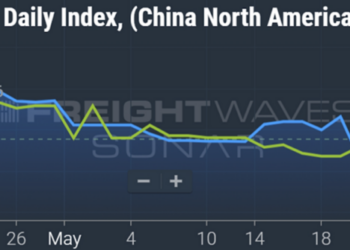The bigger they come, the harder they fall. The shipping boom in the trans-Atlantic market was one of the world’s biggest, and spot rates in this trade have not only plummeted from COVID-era highs, they’ve sunk below pre-pandemic levels.
“It is probably the deepest and fastest decline I have seen in my history [in the business],” said Thorsten Meincke, head of ocean and air freight at German freight forwarder DB Schenker, during an online panel discussion Tuesday.
According to Peter Sand, chief analyst at freight-rate data provider Xeneta, “This is a major meltdown for a trade that was steady and ‘dull’ for decades before suddenly becoming the poster boy of the container freight market in 2022, defying gravity with elevated rates for a long time after the rest of the market had crumbled.”
Israel-based ocean carrier Zim (NYSE: ZIM) is benefiting from the recent jump in spot rates in the trans-Pacific, but its CFO, Xavier Destriau, stressed that these gains are being offset by falling rates in the trans-Atlantic.
“There is intensified pressure in the Atlantic trade lane,” warned Destriau on Wednesday’s second-quarter earnings call. “It had been extremely resilient up until recently. Today, it is under severe pressure.” The trans-Atlantic accounted for 13% of Zim’s volumes in the first half.
Jefferies analyst Omar Nokta also cited fallout from markets like the trans-Atlantic. Zim’s rate gains in the trans-Pacific are “offset by weakness elsewhere,” said Nokta. “Simply put, gains are needed outside the trans-Pacific for Zim’s earnings to turn green.”
Carriers poised to pull capacity
Germany-based ocean carrier Hapag-Lloyd is heavily exposed to the trans-Atlantic market.
According to analytics group Alphaliner, Hapag-Lloyd is the second-largest carrier in the Europe-U.S. market, with a 20% share as of July 1. Only MSC is bigger, with a commanding 38% share. The Atlantic trade accounted for 18% of Hapag-Lloyd’s first-half volumes, the company said in its latest earnings release.
Hapag-Lloyd CEO Rolf Habben Jansen addressed Atlantic shipping weakness in both the Aug. 10 quarterly call and Tuesday’s online panel discussion with DB Schenker.
“The Atlantic has gone to a very, very low level,” he said. Asked whether sailings need to be canceled as a result, Habben Jansen replied, “We’re actively looking at that. In some cases, we don’t earn back our costs. We need to do things to keep our costs under control. I wouldn’t be surprised if we do something fairly soon.”
Alphaliner highlighted the rise and fall of the Europe-U.S. trade in a recent report. “As soon as the big east-west trades — from the Far East to North America and Europe — cooled down after the COVID-19 pandemic, carriers began shifting capacity to the Europe-North America trade, where ocean rates were much higher,” Alphaliner recounted.
The incremental tonnage chasing high trans-Atlantic rates led to overcapacity in relation to demand, pushing rates back down, which should ultimately drive vessels back out of the trade — yet another example of competitive shipping markets in action, and the business adage: “The best cure for high prices is high prices.”
“The party is over for liner operators [in the trans-Atlantic],” wrote Alphaliner. “MSC, which is by far the largest carrier in this trade, has already started to remove tonnage.”
Spot rates down double digits vs. pre-COVID levels
How far have trans-Atlantic rates fallen? Different index providers give different numbers, but they all show the same precipitous collapse to levels below the pre-pandemic “normal.”
According to the Drewry World Container Index (WCI), spot rates from Rotterdam, Netherlands, to New York peaked in early November 2022 at $7,426 per forty-foot equivalent unit. In the week ending Aug. 10, they had fallen 79% from that high, to $1,593 per FEU. Compared to pre-COVID rates, the current WCI assessment is 19% below levels at this time in 2018 and 33% below levels in 2019.
Looking even further back, the current WCI Rotterdam-New York spot assessment is lower than at any point in at least 12 years. (Drewry’s data on FreightWaves SONAR only goes back to 2011.)
Weekly spot rate in USD per FEU. (Chart: FreightWaves SONAR)
The Freightos Baltic Daily Index (FBX) Europe-East Coast spot assessment peaked at $10,708 per FEU in early June 2022. As of Wednesday, it had fallen 88% from that high to $1,236 per FEU. According to the FBX, trans-Atlantic westbound rates have been below pre-COVID levels since late June. They were 29% below 2019 levels on Wednesday.
Daily spot rate in USD per FEU. Blue line: 2023. Purple line: 2019. (Chart: FreightWaves SONAR)
Trans-Atlantic contract rates more than double spot rates
Xeneta tracks both short-term (spot) and long-term (contract) rates. Xeneta’s data shows the same crash in spot rates, but also, that contract rates remain much higher than pre-COVID levels and much higher than current spot rates.
Xeneta put average spot rates in the North Europe-East Coast lane at $1,510 per FEU as of Thursday, down 83% from the peak of $8,793 per FEU in mid-May 2022 and down 35% from spot rates at this time in 2019, pre-COVID.
In the trans-Pacific, Xeneta data shows that spot rates have recently risen above contract rates. The trans-Atlantic is seeing the exact opposite dynamic. Thursday’s average long-term rate in the North Europe-East Coast lane was assessed at $3,378 per FEU, more than double spot rates (124% higher) and 77% above contract rates at this time in 2019.
(Chart: Xeneta)
This implies that carriers are still doing exceptionally well in the trans-Atlantic to the extent they’re moving contract volumes, not spot cargoes.
However, it also suggests a major risk to carriers’ contract business. When contract rates far exceeded spot rates in the trans-Pacific during the second half of 2022, many shippers switched their cargo to the much-cheaper spot market. Some carriers, including Zim, agreed to slash annual rates in midcontract to keep their volumes. The current spread in the trans-Atlantic implies the same threat to contract business in this lane.
Click for more articles by Greg Miller
Related articles:
Shipping line Zim bets big on spot market as losses mount
July import volumes continue to mirror pre-COVID ‘normal’
Asia-US spot rates top contract rates for first time since 2022
Maersk hikes 2023 guidance but warns of ‘years’ of challenges
Trans-Pacific shipping rates rise as carriers make capacity cuts
Trans-Atlantic shipping rates keep sinking as imports from Europe fall
Trans-Atlantic container rates still double pre-COVID levels
Good times still rollin’ for shipping lines in trans-Atlantic trade
The post Trans-Atlantic shipping suffers ‘meltdown’ as rates hit new low appeared first on FreightWaves.













